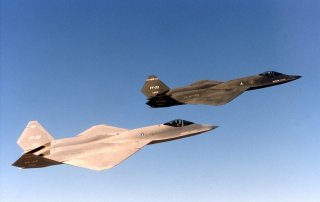The Air Force Rejected the YF-23. Did It Make a Mistake?
Buying F-23s instead of F-22s wouldn’t have changed the recent arc of U.S. history. So what's with all the mystique?
Here's What You Need to Remember: For its entire 72-year-history, the Air Force has based its air-superiority concepts on fighter aircraft.
The mystique that today surrounds Northrop Grumman’s YF-23 isn’t entirely healthy. It reflects a tendency in many Americans to look for technological solutions to human problems.
Buying F-23s instead of F-22s wouldn’t have changed the recent arc of U.S. history. It wouldn’t have stopped Russia’s resurgence or China’s rise as a world power. Trading Lockheed’s stealth fighter for Northrop’s own plane wouldn’t have halted the spreads of radical Islamic terrorism and right-wing militancy.
But the development and flight-testing of the YF-23 do offer important lessons for the Air Force as it begins studying a replacement for the F-22. The Air Force in 2016 published its “Air Superiority 2030” study, which called for a new “Penetrating Counter Air” system to supplant the service’s roughly 180 F-22s beginning in the 2030s.
The Air Force in 2017 initiated an analysis of alternatives to further refine concepts for the Penetrating Counter Air system. Service officials have said they strongly are interested in a “disaggregated” approach to air superiority that involves a wide array of systems working together.
That approach could represent a break from the past. For its entire 72-year-history, the Air Force has based its air-superiority concepts on fighter aircraft.
It seems highly likely that the new Penetrating Counter Air system will include fighters, but more than before these fighters might coordinate with drones and air-, space- and ground-based networks, sensors and weapons.
But if the YF-23 program is any indication, it could take longer than 15 years to invent a new air-superiority system, whatever form it takes. The Air Force in 1971 began studying requirements for a new fighter to succeed the F-15, which itself at the time was still in development, according to Paul Metz, a former Northrop test pilot who flew the YF-23.
Metz in 2015 spoke at length about the YF-23 in a lecture series at the Western Museum of Flight in California.
Studies continued for 10 years before the service finally approached the aerospace industry. The Air Force in 1981 asked nine companies to pitch new fighter designs. Seven responded. The Air Force in 1986 tapped Lockheed and Northrop each to build and test two prototypes. The deadline was in 1991.
The Air Force’s requirements were both vague and ambitious. The only specifications were that the new fighter be fast, far-flying, maneuverable and stealthy. “We were asked to create something that had never existed,” Metz said.
To its credit, the Air Force didn’t try to tell the companies exactly what the service meant by “fast, far-flying, maneuverable and stealthy” or how they should achieve those goals. “The Air Force did a great job of leading,” Metz said. “It had the concept of letting us try it out and experiment.”
Likewise, the Air Force didn’t pit the resulting YF-22 and YF-23 prototypes against each other. Rather, the two companies each pursued its own independent flight-test program. “It was not a fly-off,” Metz stressed.
That mattered. The YF-22 and YF-23 were very different airplanes, each with its own design trade-offs and approaches to achieving the fast-far-stealthy requirement. The YF-23 was faster. The YF-22 arguably was nimbler. The YF-23 pushed the boundaries of avionics technology. The YF-22 probably was easier to build. “You can’t make apples-to-apples comparison,” Metz said.
If the Air Force applied the lessons it learned from the YF-22 and YF-23 to a new fighter concept, it would meticulously study the problem before loosely defining it for industry to solve. And the service would avoid micromanaging the developers’ efforts. Finally, the service would assess the results on their own merits rather than comparing dissimilar solutions.
And the Air Force would avoid some obvious mistakes. In overseeing the YF-22 and YF-23, the service for example insisted that Lockheed and Northrop hide their prototypes from enemy spy satellites by never displaying the planes out in the open.
Bewildered Northrop engineers “solved” the problem by covering the YF-23 with plastic tarps … that promptly blew away in the strong winds at Edwards Air Force Base in California.
That “lunacy … obviously didn’t last very long,” Metz said.
David Axe was Defense Editor of the National Interest. He is the author of the graphic novels War Fix, War Is Boring and Machete Squad. This article is being republished due to reader interest.
Image: Wikipedia.

